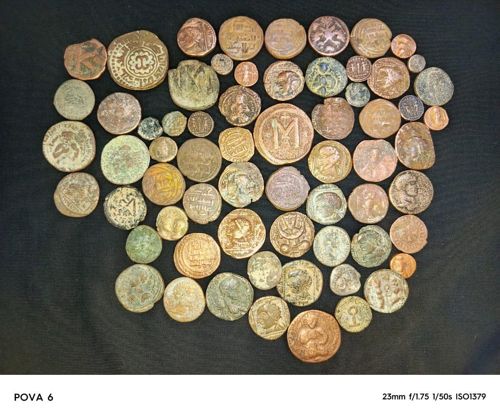Ancient/Medieval Bronze/Copper Coin (various types)
Country of Origin: Likely various regions, potentially Roman, Byzantine, Islamic, or other ancient/medieval empires in the Mediterranean/Middle East.
Year of Issue: Highly variable, likely spanning a broad period from the Roman Imperial era (e.g., 3rd-6th centuries AD) through the Byzantine and early Islamic periods (e.g., 7th-10th centuries AD), possibly even later medieval periods. Precise dating requires individual identification of each coin.
Denomination: Various minor denominations (e.g., Follis, Nummus, or smaller copper units, depending on origin). Specific denominations are difficult to determine without clearer images of individual coins.
Composition: Bronze, Copper, or copper-alloy (likely mixed metals due to ancient manufacturing processes)

Brief Description
The coins in the image appear to be ancient or medieval bronze/copper coins, likely from various origins given the diverse designs. Many show signs of heavy wear, corrosion, and patination, indicating significant age. Some coins feature legible inscriptions or symbols, such as what appears to be a large 'M' on one prominent coin, or various forms of cross-like symbols. The shapes are generally round, though many are irregularly shaped due to wear and production methods.
Historical Significance
These coins represent fragments of ancient and medieval economic systems. They were used for daily transactions, and their designs often reflect the political, religious, and cultural iconography of the issuing authority. The presence of numerous bronze/copper coins suggests their role as common currency for the general populace. They can provide valuable historical insights into trade routes, imperial control, and the beliefs of past civilizations.
Estimated Value
Highly variable. For unidentifiable or heavily worn ancient bronze/copper coins, individual pieces could range from a few dollars to tens of dollars. If any rare types, well-preserved examples, or specific historical periods are identified, the value could increase significantly to hundreds or even thousands for exceptional pieces. Without specific identification, a general estimate for the collection as seen could be in the low to mid hundreds of dollars, but this is a very rough estimate.
Care Instructions
Given their age and material, these coins are likely delicate. They should be handled as little as possible, and only by the edges to avoid transferring oils from skin. Storage should be in a dry, stable environment, ideally in inert materials like Mylar flips or non-PVC coin holders to prevent further corrosion. Cleaning is generally not recommended for ancient coins as it can severely reduce their historical value and damage the patina. If cleaning is absolutely necessary, it should only be performed by a professional conservator.
Created At: 2025-08-12T15:05:42.982842